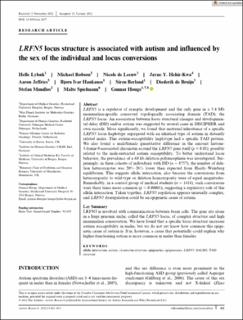| dc.contributor.author | Lybæk, Helle | |
| dc.contributor.author | Robson, Michael | |
| dc.contributor.author | de Leeuw, Nicole | |
| dc.contributor.author | Hehir-Kwa, Jayne Y. | |
| dc.contributor.author | Jeffries, Aaron | |
| dc.contributor.author | Haukanes, Bjørn Ivar | |
| dc.contributor.author | Berland, Siren | |
| dc.contributor.author | de Bruijn, Diederik | |
| dc.contributor.author | Mundlos, Stefan | |
| dc.contributor.author | Spielmann, Malte | |
| dc.contributor.author | Houge, Gunnar Douzgos | |
| dc.date.accessioned | 2022-08-16T07:08:47Z | |
| dc.date.available | 2022-08-16T07:08:47Z | |
| dc.date.created | 2022-05-18T13:05:40Z | |
| dc.date.issued | 2022 | |
| dc.identifier.issn | 1939-3792 | |
| dc.identifier.uri | https://hdl.handle.net/11250/3012000 | |
| dc.description.abstract | LRFN5 is a regulator of synaptic development and the only gene in a 5.4 Mb mammalian-specific conserved topologically associating domain (TAD); the LRFN5 locus. An association between locus structural changes and developmental delay (DD) and/or autism was suggested by several cases in DECIPHER and own records. More significantly, we found that maternal inheritance of a specific LRFN5 locus haplotype segregated with an identical type of autism in distantly related males. This autism-susceptibility haplotype had a specific TAD pattern. We also found a male/female quantitative difference in the amount histone-3-lysine-9-associated chromatin around the LRFN5 gene itself (p < 0.01), possibly related to the male-restricted autism susceptibility. To better understand locus behavior, the prevalence of a 60 kb deletion polymorphism was investigated. Surprisingly, in three cohorts of individuals with DD (n = 8757), the number of deletion heterozygotes was 20%–26% lower than expected from Hardy–Weinberg equilibrium. This suggests allelic interaction, also because the conversions from heterozygosity to wild-type or deletion homozygosity were of equal magnitudes. Remarkably, in a control group of medical students (n = 1416), such conversions were three times more common (p = 0.00001), suggesting a regulatory role of this allelic interaction. Taken together, LRFN5 regulation appears unusually complex, and LRFN5 dysregulation could be an epigenetic cause of autism. | en_US |
| dc.language.iso | eng | en_US |
| dc.publisher | Wiley | en_US |
| dc.rights | Navngivelse-Ikkekommersiell 4.0 Internasjonal | * |
| dc.rights.uri | http://creativecommons.org/licenses/by-nc/4.0/deed.no | * |
| dc.title | LRFN5 locus structure is associated with autism and influenced by the sex of the individual and locus conversions | en_US |
| dc.type | Journal article | en_US |
| dc.type | Peer reviewed | en_US |
| dc.description.version | publishedVersion | en_US |
| dc.rights.holder | Copyright 2022 the authors | en_US |
| cristin.ispublished | true | |
| cristin.fulltext | original | |
| cristin.qualitycode | 1 | |
| dc.identifier.doi | 10.1002/aur.2677 | |
| dc.identifier.cristin | 2025208 | |
| dc.source.journal | Autism Research | en_US |
| dc.source.pagenumber | 421-433 | en_US |
| dc.identifier.citation | Autism Research. 2022, 15 (3), 421-433. | en_US |
| dc.source.volume | 15 | en_US |
| dc.source.issue | 3 | en_US |

